Volume 1, Issue 2
August 10, 2022

In This Issue: Copy This Website! | Sign of the Times | Bright Spots | Rancho Cordova | Supporting Each Other | EAP Tips | Expanding Learniverse | Paws to Appreciate | We Dream Different
We are so excited to announce the completion of the Open Grant application review: We have awarded over 6 million dollars in shelter grants, bringing the total dollars awarded through California for All Animals to over $7,500,000 since its launch on Valentine’s Day 2022!
Details are still being finalized and will be released as soon as they are available, but we want to keep you informed every step of the way.
Proposals were assessed using a formula that weighted impact, community vulnerability, and need. The social vulnerability index[1] helped identify shelters in areas of high vulnerability, while shelter data such as annual intake, euthanasia rates, helped measure potential impact. Shelters and animal control agencies located within the highest vulnerability index regions were prioritized as well as programs that provide free or low-cost services to keep pets in homes.
Funding has been prioritized in the following areas:
- Spay/Neuter surgeries for shelter animals and to keep pets in homes
- Access to veterinary care in communities where resource deserts exist
- Shelters in areas of high vulnerability or with high euthanasia rates
- Increasing outcomes such as foster, adopt and return to home that remove barriers and promote inclusivity and equity
- Humane housing for animals in shelters such as double-compartments for dog kennels
- Reducing euthanasia of healthy and treatable animals
- Resources to keep pets in homes, allowing animal control agencies to offer services as an alternative to impoundment
Expanding access to spay and neuter services was paramount this funding cycle and will remain a priority for the life of this program. As many of you know and are experiencing firsthand, length of stay in the shelter is climbing, while medical capacity and adoptions are declining, two factors that are contributing to shelter bottlenecks and reducing positive outcomes for animals entering shelter systems. Initiatives that support shelter-community integration and prevent unnecessary shelter intake, such as community/volunteer engagement and family-led rehoming, were selected outside the shelter, while initiatives that support animal well-being, such as double compartment housing or behavior, training and enrichment programs, were favored inside the shelter to reduce the length of stay for animals experiencing an emergency and for whom the shelter is the right place to receive care.
Last but certainly not least, initiatives that reduce the number of barriers between pets and people were prioritized. Examples include expanding access to affordable pet care; removing restrictive, fear-based adoption policies that are not supported by science and not in line with equity and inclusion; waiving reclaim fees; streamlining foster/volunteer onboarding (including making orientations and training available online); and introducing field service initiatives that focus on strengthening the human-animal bond and the relationship between community and animal services, or provide problem-solving resources to help community members keep their pets or support those willing to foster short-term.
Measuring risk in vulnerable populations
[1] Natural disasters and infectious disease outbreaks can pose a threat to a community’s health. Socially vulnerable populations are especially at risk during public health emergencies because of factors like socioeconomic status, household composition, minority status, or housing type and transportation. To help public health officials and emergency response planners meet the needs of socially vulnerable populations in emergency response and recovery efforts, the Geospatial Research, Analysis, and Services Program (GRASP) created and maintains the CDC/ATSDR Social Vulnerability Index (CDC/ATSDR SVI).
The Social Vulnerability Index (SVI) uses U.S. Census data to determine the relative social vulnerability of every census tract. The SVI ranks each tract on 14 social factors and groups them into four related themes. Each tract receives a separate ranking for each of the four themes, as well as an overall ranking.
Read more on the CDC’s SVI website.
Copy, Paste: Off the Shelf Website Copy for Your Animal Shelter
Do you know what’s on the homepage of your website? Could you easily navigate to a page that tells community members what to do (and what not to do) if they come across a dog, healthy free-roaming cat, kitten, or sick or injured animal? Or what to do if they’ve lost their pet? Could your parent, grandparent, or neighbor find that information easily? It’s a great time for a website check-up: Is yours working as well as it could for you and your community?
Not everyone will visit your website before calling or coming to the shelter, but many will. And if you’re a municipal shelter, chances are your pages are among the most viewed on your county website! Your shelter website can do more than convey essential information. It’s an extension of your building that reaches beyond your doors and into the community, and it’s an opportunity to tell your story and have a hundred meaningful conversations all at once—with finders, potential adopters, fosters, volunteers, and donors.
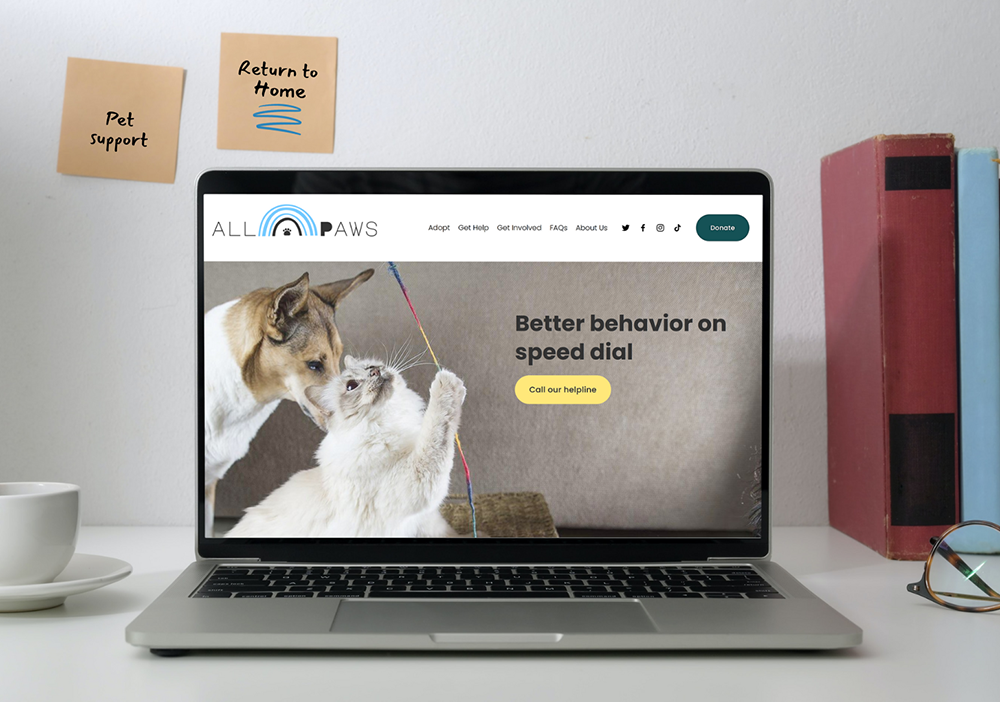
To make it easier for you to refresh your website and align your messaging with tried and true practices, we’ve created a sample shelter site filled with copy and templates you can reuse and adapt! This sample site highlights the best ideas and resources from your partner organizations and peers and was designed to help you accomplish four important goals:
Share lifesaving information with your community.
You know which actions and interventions will allow you to serve the largest number of pets and people in the Right Place, at the Right Time, providing the Right Care, to the Right Outcome; make sure you share these practices with your community! We’ve included step-by-step suggestions for finders of cats, dogs, and kittens, and tips for people who have lost their pets. The sample site also demonstrates how to make it easy for visitors to discover support and resources available to them within the shelter and community, from videos for kitten-finders to guidance on pet rehoming, and it spotlights the convenience of making appointments for non-emergency services—recognizing that appointments can improve the quality of service as well as animal health and well-being in the shelter. Don’t forget to consider translating key materials into the languages spoken in your community.
Equip staff with resources to help guide conversations with community members.
Decision trees and SOPs are must-have tools for reducing decision fatigue and helping public-facing staff communicate effectively whether on the phone, via e-mail, or in-person. When website messaging coincides with these proven policies and practices, staff can supplement conversations by easily directing community members to helpful pages that share more information on available free or low-cost clinics or other support services, offer research-based overviews of hot topics, answer frequently asked questions, and more.
Your website is an opportunity to proactively and transparently tell a new story that more accurately reflects community-centered shelter programming and goals at every level, one that emphasizes what we know to be true: The well-being of animals and the people who care for them is interconnected.
Tell your story.
As Kristen Hassen has written, the dog pound is dead, yet many people don’t understand the full scope of shelters’ work today. Your website is an opportunity to proactively and transparently tell a new story that more accurately reflects community-centered shelter programming and goals at every level, one that emphasizes what we know to be true: The well-being of animals and the people who care for them is interconnected. Building communities in which people and pets are supported is an essentially collaborative endeavor. Throughout the sample site, we’ve included language and photos that reflect this. As you think about how to convey your organization’s particular story, ask, Who are you, and what work do you aim to do? What matters to you and to your community, and what common values and beliefs shape your work and the way you show up in your community?
Invite and empower your community to collaborate with you and signal your own openness to collaboration.
Communicating with your community isn’t a one-way street. When it comes to animal sheltering, engaging your community is an ongoing process to improve communication, build trust, develop and strengthen relationships with community members and partners, and improve outcomes and grow community well-being through teamwork. There can be no us and them; whether shelter staff, rescue volunteer, or neighbor, we are all affected when the welfare of people and animals suffer, and we all benefit when people and animals can access the support they need when they need it. A California for All Animals starts with establishing connections and nurturing relationships, so that all of us can work toward this shared vision together.
Explore the sample shelter website and let us know if you have any ideas or resources to share. If you’re feeling overwhelmed or need help adapting materials for your website, we’re always here to help!
Sign of the Times
Can a reminder to be kind make your shelter a calmer place? When a friend of the KSMP went to her private veterinarian recently, she experienced a longer-than-usual wait. A giant sign in the lobby explained why. “Thank you for your patience & kindness to our staff,” the sign begins. “We respect you and want to share our current reality.”
What follows is a list of historical trends and current challenges that provide context the client might not otherwise be aware of:
- Pet ownership is at an all-time high
- Burnout is on the rise
- There is a national shortage of veterinarians
- What are we doing to improve these situations?
- We cherish the human-animal bond as you do
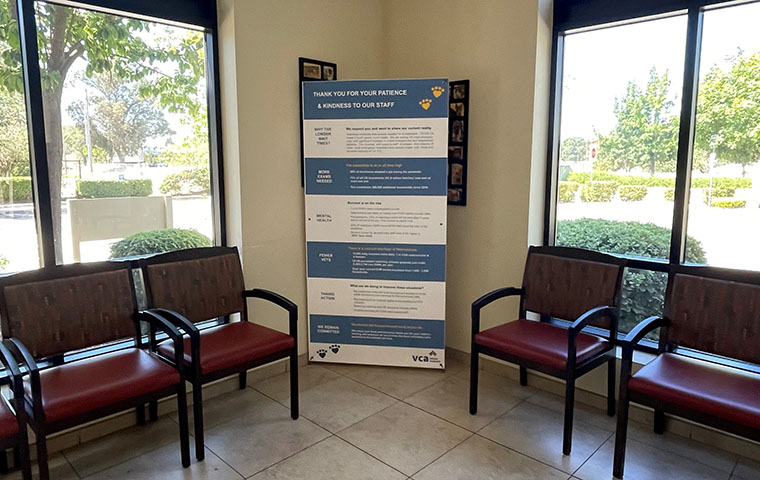
“During my wait, a dozen people read that sign and one by one I watched their energy change the instant they started reading,” said Kristy Dwyer. “It was nice to be told what was going on. We’re all experiencing staffing shortages and can understand the need to triage. It actually inspired me to embrace greater transparency at my own workplace.”
Hospital Administrator Margit Spencer was kind enough to share the “Be Kind” document used to create the pop-up. You can borrow from it to share a similar message in your lobby. The document is flyer-sized, but Margit recommends blowing it up to poster size; installing the pop-up shown above was considerably more effective at bringing out clients’ better angels than handing out the same information at the counter.
People who are stressed and anxious are not interested in hearing “excuses.” It’s important to share the concrete steps you’re taking to provide the best care you can given the circumstances. It’s also important to establish that we all want the best experience and outcome for animals and their people.
The most recent report from Shelter Animals Count (SAC) points out that even though animal shelter intakes are down in the first six months of this year compared to the same time period last year, the intakes are still outpacing outcomes by 5.8% . Worse yet, the SAC forecast is for that number to increase in the second half of the year. You may know you’re over capacity, but your clients probably don’t know that…or how that affects your operations. Being transparent about your challenges as well as your commitments offers perspective that can bring out the best in people when they visit.
Are You Covered and Don’t Even Know It? Getting the Most Out of Your Policy
Only 3.5% of employees take advantage of their Employee Assistance Program. Why? The vast majority of employees don’t know the range of services offered or how to access them.
An Employee Assistance Program (EAP) is a voluntary, work-based program that offers free and confidential assessments, short-term counseling (e.g., 5–12 visits per “issue,” though there is no limit to the number of issues that may cause you to seek counseling services), referrals, and follow-up services to employees who have personal and/or work-related concerns. EAPs address a broad and complex body of issues affecting mental and emotional well-being, such as overwhelm, compassion fatigue, stress, grief, family conflict, legal issues, addiction, and psychological disorders. In recent years, many EAPs have expanded their services to include help with transitioning into retirement, budgeting, coping with sudden death or natural disaster, and everyday tasks like planning a vacation or locating childcare.
EAP counselors also work in a consultative role with managers and supervisors to address employee and organizational challenges and needs. Many EAPs are active in helping organizations prevent and cope with workplace violence, trauma, and other emergency response situations.
Ask your human resources representative if your organization has enrolled in an EAP program and how you can access the free services!
The Learniverse Is Expanding
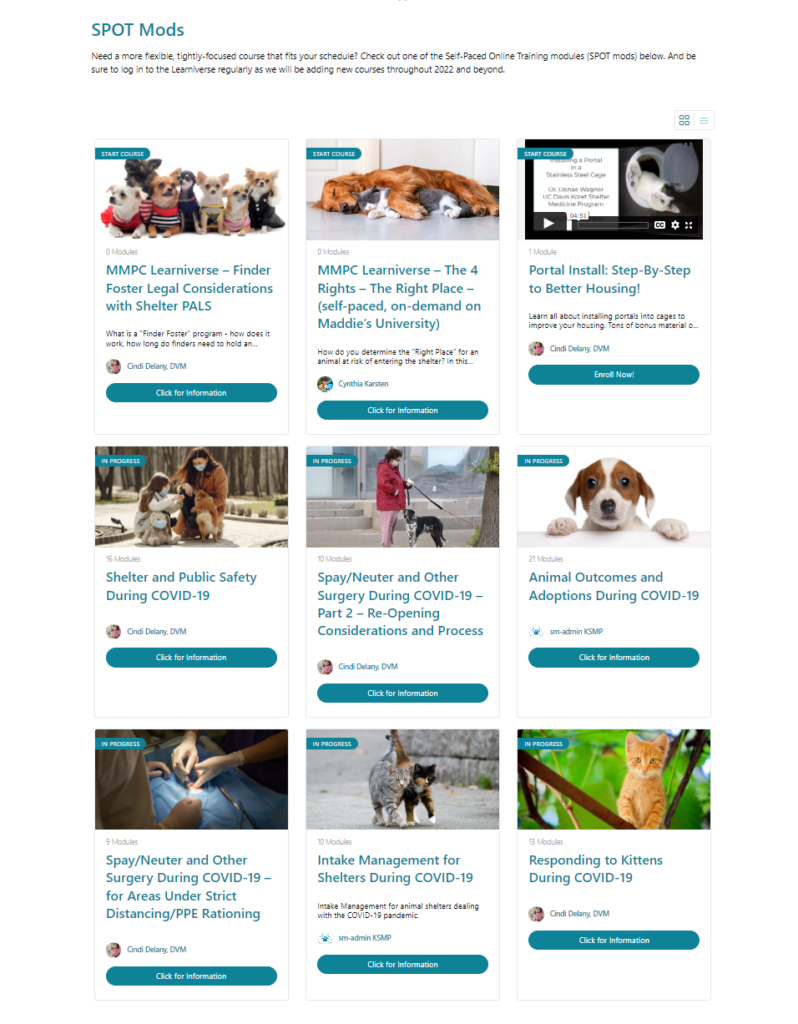
- MMPC Finder-Foster Legal Implications with Shelter PALS
- The Four Rights: The Right Place
- The Four Rights: The Right Time
- Population Management and Daily Rounds Bootcamp
Stop by the Maddie’s® Million Pet Challenge Learniverse often and never miss out on new training opportunities for you and your staff! Recently, three new Self-Paced Online Training modules (SPOT mods) were added to the course lineup, as well as a brand new, six-week Bootcamp.
Paws to Appreciate…
Shelters that are supporting helpers by offering microchip scanners!
This microchip scanner by Tosuny retails for only $29.99 on Amazon and provides finders with the chip number needed to search national databases like AAHA.org.

Mapping the Movement
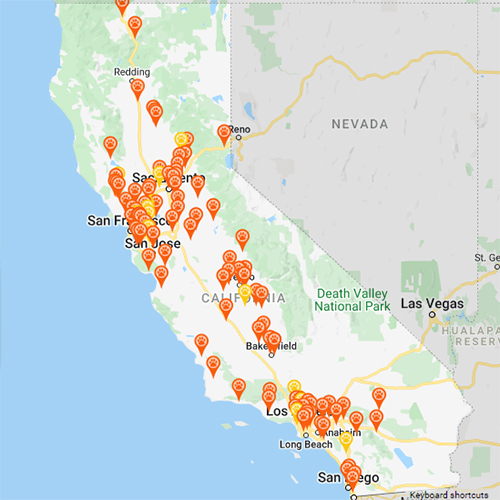
Notice anyone missing? Tell them about California for All Animals!
Bright Spots:
Could you watch these kittens all day, too?
How it started:
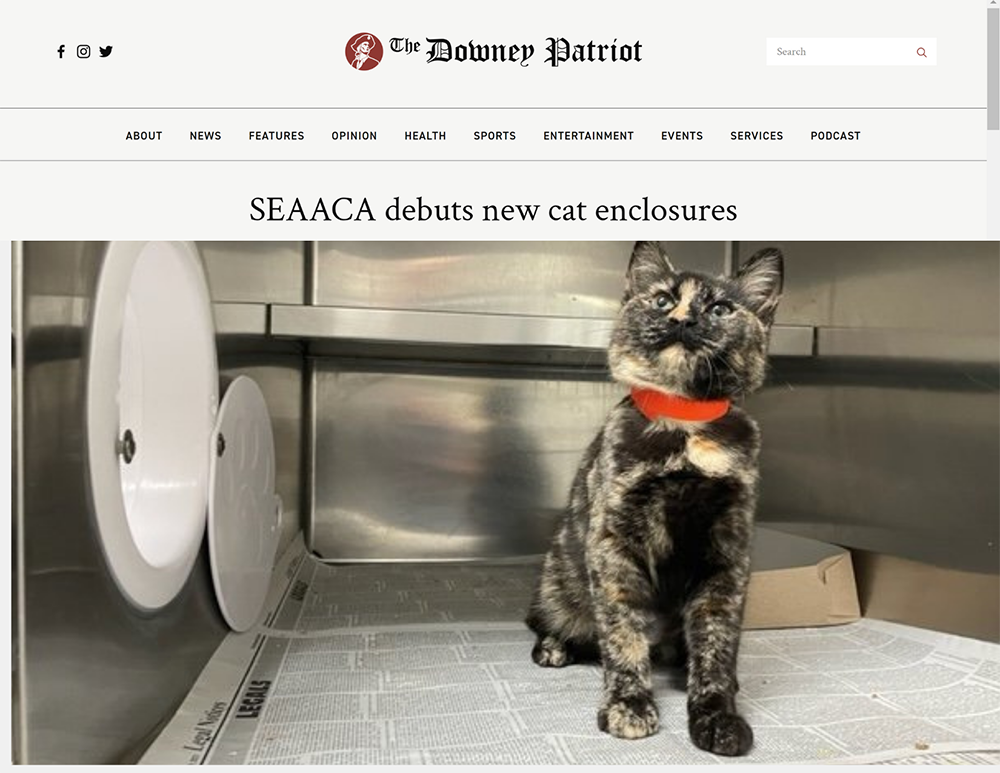
How it’s going:
video credit: Donna Soriano
Going All Out for the Community in the Field
City of Rancho Cordova Animal Services recognizes that success for their community starts with field officers providing neighborhood-level support that keeps people and pets together, whether it’s boosting return to home efforts, supplying dog housing or fencing materials, or developing programs to pay renters’ pet deposits and expand access to care.
“As Field Services staff,” they note, “we often see the inability to pay vet bills leading to people surrendering their beloved pet.” With Open Grant funding secured for their Animal Services Community Support Program, they hope to help people avoid the heartbreaking choice prompted by an unexpected medical expense or lack of affordable, pet-friendly housing—and create more opportunities to connect with community members.
Senior Animal Services Officer Craig Hall and his team already know the impact that can come from building individual relationships with community members. Recently officers worked with a concerned resident to trap a community cat with an injured tail. The resident expected the cat would be euthanized, but after a tail amputation at the Sacramento SPCA, the cat was returned and, to the resident’s delight, is now comfortable enough to cozy up indoors.

We can’t wait to see how Rancho Cordova Animal Services’ big ideas continue to benefit the people and animals of Rancho Cordova!
Supporting Each Other
How do we help ourselves, our employees, and our company culture during a difficult and overwhelming time?
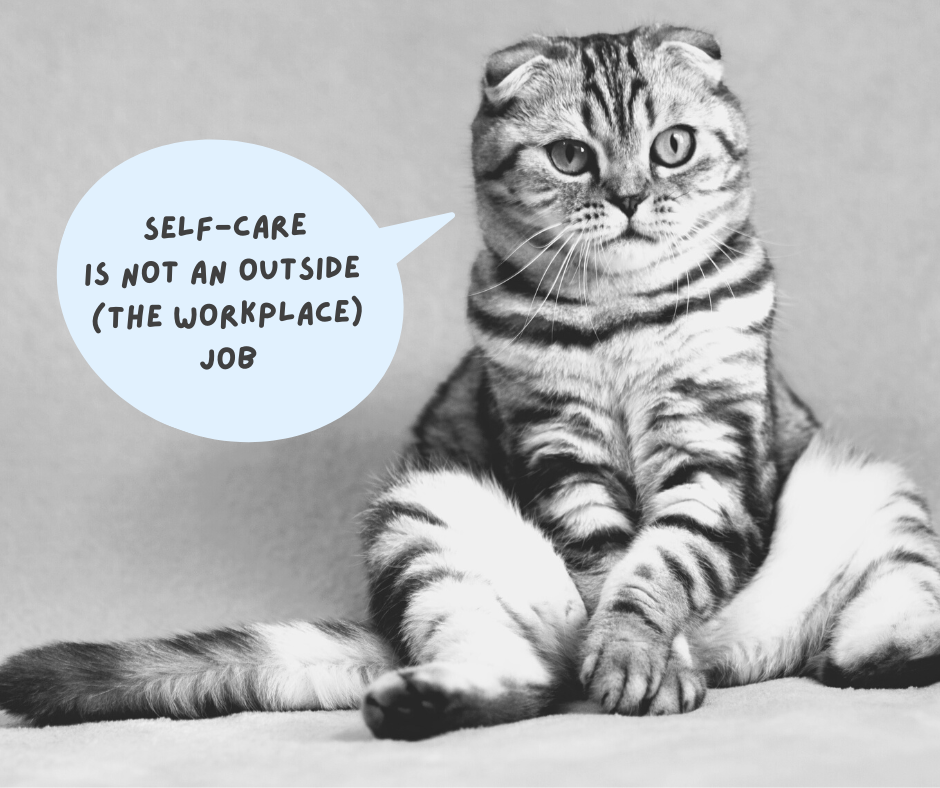
We’ve never needed a reason to prioritize employee wellness, but the list of benefits has grown beyond human kindness, good workplace culture, increased productivity and better customer service to include the words on everyone’s lips: employee recruitment and retention.
A Harvard Business School study found that avoiding a toxic worker was worth about $12,500 in turnover costs—and even more to replace them and onboard new employees! Forbes reports entry-level employees cost between 30–50 percent of their annual salary to replace. For mid-level employees, that number climbs to upwards of 150 percent of their annual salary.
Here’s a short list of things you can do to care for and stabilize your team during difficult times:
Support others by supporting yourself. Model and normalize self-care practices. Enlist the mental health support services you need when you need them.
Speak openly about caring for your mental health and our industry’s predisposition to compassion fatigue. Know what compassion fatigue looks like and the resources available to manage it.
Be authentic. Recognize that you may have the unintended consequence of adding to feelings of hopelessness by promoting self-care but providing working conditions and expectations in which practicing self-care is difficult or impossible. The same goes for suggesting self-care practices that are outside the means of your staff.
Pay fairly. Financial stress is a chronic stress that affects every area of our lives. The less you make, the more stress you have—and the fewer resources you have to manage and deal with that stress. Burnout is a result of prolonged stress.
Walk the walk. Is working the hardest/longest praised? Understand the toxic culture of a chronically understaffed system and make hiring the appropriate number of staff a priority.
Self-care is not an outside (the workplace) job. During the workday, encourage walking meetings, don’t eat lunch at your desk, be flexible (studies show employees stress less when they can take calls and schedule appointments during work hours), demonstrate work-life balance, and let your staff/peers know it’s okay to put yourself first sometimes.
Create a wellness initiative at work; introduce wellness check-ins and encourage employees to self-assess their mental well-being. Create an improvement pathway for employees who have concerns.
Raise awareness. Does your organization have an Employee Assistance Program? Share it! Assign an awareness advocate to go desk-to-desk, email-to-email, workstation-to-workstation and ensure every employee knows how to access the resources over 95% of people aren’t utilizing!
Don’t shy away from having a conversation when you notice an employee is struggling. Have a list of resources that are provided by their policy and/or are readily available and free, such as the National Alliance on Mental Illness, Mental Health America Staying Mentally Healthy and Finding Help. Mental Health America also operates a hotline. If you or someone you know is struggling or in crisis, help is available. Call or text 988 or chat 988lifeline.org. You can also reach Crisis Text Line by texting “MHA” to 741741.
Don’t sugarcoat the truth: Front-line employees across the board, from flight attendants to teachers, are experiencing an uptick in abuse. Acknowledge the problem, provide training and resources in de-escalation to manage situations as they arise, and have each other’s back when they do.
Empower your team. Does your staff regularly encounter people in the public who may be experiencing a mental health crisis? Empower employees to respond appropriately by offering training, such as Mental Health First Aid Training.
Help employees find the time. Make health a habit by setting a standing and recurring time on the All Staff calendar in which all employees are invited to schedule wellness into their calendar. Maybe it’s taking time to convert a few meetings to walk and talks, possibly it’s that 15 minutes you need to find out how to access your EAP benefits or schedule that free yoga-in-the-park class.

